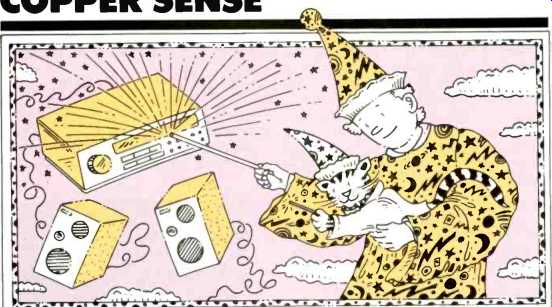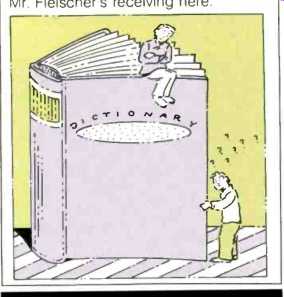COPPER SENSE

Wire Talk
Frank Van Alstine runs a quality audio store called Audio by Van Alstine (formerly Jensen's Stereo Shop) in Burnsville, Minnesota. He's generally regarded as a pretty good electronics engineer and has occasionally issued products that show excellent grasp of the principles involved, together with innovative thought. The following is from Van Alstine's newsletter, Audio Basics.
We let the copy speak for itself. "Too may readers want me to tell them what magic cable and speaker wire to use! They don't want me to be honest and explain that there is no correlation between cable quality and price. They certainly don't want me to inform them that the only difference between the 'sound' of various cables is the way the real electrical characteristics of the cable-the resistance, capacitance, and inductance-load the driving source.
They don't want me to say that any sonic differences can be replicated with 100 worth of resistors, capacitors, and inductors wired across the cable. They don't seem even to want to know that, if an amplifier is not load sensitive, the characteristics of the cable won't matter at all. None of that good electrical engineering advice is any fun at all.
"Magic is a lot more fun and is much easier to understand. So I keep getting call after call, and letter after letter, asking me only what brand of magic cable I recommend. And when I respond, the answer is perceived to be that I don't like magic cables.
Wrong again! I don't like fraud. I don't like products that are represented and priced to have some mystic quality that does not exist and that the supplier knows does not exist. I don't like the fact that the entire high-end and mid-fi market has taken up selling high-priced cables as a way of making a quick buck and convincing you that their shiny pennies are fair trade for your quarters.
"I don't like magazine reviewers mindlessly listening to and evaluating magic cables and wires in endless, nauseating reviews without ever thinking about what is going on, about what they are really hearing or not hearing, and why. The concept that most electronics are excessively load sensitive and that changing the load changes the sound seems to be an alien thought too hard to understand. The concept that if the cable changes the sound, then the real problem is the source driving the cable, is never discussed.
Nobody is willing to stand up and shout, 'Bullshit!' "So when I demonstrate at a Show, obviously using standard cables and interconnects, I get to spend my time explaining why the sound was so good with 'bad-sounding' wires. Far too many of the visitors to our room were so brainwashed that they never understood that the sound was good because the equipment was not screwing up the source material, because I had done an adequate job of getting rid of the worst of the room's acoustic problems, and because the brand and cost of the cables did not matter at all."
Stereopticonfusion

The "stereopticon" slide of the Eiffel Tower in the January "Spectrum" was actually a stereoscope slide. I humbly accept this correction from Kenneth H. Fleischer of San Francisco, for the sake of truth and for the sake of proving I'm not old enough to have been around when stereoscopes were in vogue.
The two words are frequently confused. In fact, I heard someone make the same error at a party two days after Mr. Fleischer's note arrived. To my surprise, my gentle correction was received only with a frosty look, not the public thanks Mr. Fleischer's receiving here.
Walkman Marches On
Few audio inventions actually revolutionize our listening lives, and the ones that do are rarely inexpensive-at least initially. So hats off to an invention that did create a revolution, and did it on the cheap:
Sony's Walkman, which celebrates its 10th anniversary this year.
To celebrate, Sony is bringing out a "Commemorative" collector's model, the WM-701S, in a production run of only 2,000 pieces. This $650 unit is a silver-plated version of the $220 WM-701C, featuring auto reverse, a wired remote control, rechargeable battery, and both Dolby B and C noise reduction. Sony also worked with Tiffany's to produce an even rarer model, the WM-701T. This model will not be for sale but will be awarded, by Sony, to "a select group of visionary leaders in the music and consumer electronics industries."
Noise in the News
Who is responsible for controlling airport noise? The federal government, say the airlines. Local government, say beleaguered airport neighbors. Who's right? The answer is still blowing in the windsocks, but a recent U.S.
Supreme Court action may help nudge the decades-old debate toward resolution. By refusing to hear a complaint brought by a Chicago suburbanite against O'Hare International Airport, the Court has opened the door for citizens to sue the city of Chicago (O'Hare's owner) for noise-related abuses. Though the case doesn't directly address the question of just who sets noise-control standards, it does tackle some closely related issues: Who's accountable for airport-noise abuses, and what's the proper forum for disputes over airport noise? "By putting the ball back into state court, so to speak, the Supreme Court is forcing Chicago to face the real costs of poor airport planning," said Joseph Karaganis, a lawyer representing the O'Hare Citizens Coalition, a group of O'Hare's neighbors. Karaganis also represents Lawrence Bieneman, whose 1984 suit charged that O'Hare's noise lowered the value of his Bensenville home.
Dismissing Bieneman's suit in December 1988, the U.S. Court of Appeals, Seventh Circuit (whose ruling referred to Bieneman as "a frequent filer"), declared that Bieneman, and anyone else, was free to sue Chicago in Illinois state court.
"All residual power," commented Karaganis, "remains with the state in redressing injuries. This is what the appeals court's decision ruled." In May 1989, the decision was upheld by the Supreme Court.
For America's airlines, local control is an uneasy prospect. "Federal agencies still have the basic responsibility," said John Meenan, an attorney for the Airline Transportation Association, based in Washington, D.C. "Airport proprietors can go no further than taking limited action in controlling noise." Imposing local airport rules would inhibit airlines' business, said Airline Transportation Association spokesman William E. Jackman, creating "situations where you can fly one kind of aircraft into one city but can't fly the same plane into another place. That is no way to run an airline." Yet across the U.S., communities and airports are taking steps to curb excessive jet noise. In California's populous Orange County, stated Karaganis, restrictions now prevent noisier jets from landing at John Wayne Airport. San Diego International Airport, among others, has a nighttime curfew.
O'Hare, the nation's busiest airport, has no such restrictions, said Karaganis, who claims that 90,000 homes in 20 Chicago suburbs are adversely affected by jet noise. He estimates a 1% to 2% drop in property value for every decibel over 65 dBA: that's a $15,000 to $30,000 loss to the owner of a $150,000 house in an area with levels of 75 dBA.
In Chicago suburbs like Elmhurst, Park Ridge, or DesPlaines, such levels are often exceeded, added Karaganis. "You get pop bottles exploding in cupboards, you get walls cracking. People can't hear themselves think. The American credo that a man's home is his castle has gotten short shrift when it comes to airport noise."
-Tony Scherman
V15 Turns XXV
It's now been 25 years since Shure Brothers introduced the first V15 phono cartridge. The original V15 featured an elliptical diamond stylus the first of its kind, as Shure and I recall--and an optimized 15° tracking angle. With the V15 Type II (1966), Shure introduced its concept of "trackability" and the first of a series of trackability test records still in use by reviewers-including ours-today.
The Type III (1973) featured a resonant frequency above the audible range and laminated pole pieces.
With the Type IV (1978), the cartridge sprouted a Dynamic Stabilizer, a viscous-damped carbon-fiber brush system that reduced low-frequency resonance, drained static electricity, and swept dust and dirt from the groove. When Shure figured out how to make its beryllium MicroWall stylus shank (1982), they introduced the Type V, whose box doubled as a neat cartridge-alignment tool. One year later, the Type V gained a MicroRidge Stylus tip to become the V15 Type V-MR. So far, no Type VI has been hinted at, but even in this CD-oriented era, who knows?
Fourplay
Not content with merely stretching the CD's play length, as other companies have done ("Spectrum," September and December 1988), Nimbus wants to double or quadruple it. In their labs, they've succeeded in packing the pits on a disc twice as close as usual-and think they can double that. Playing the resulting "CD4X" discs would require a blue laser, and the only solid-state blue laser we've heard of is an experimental Matsushita device which costs about $10,000.
Nimbus says the CD4X will be used for computer data and video use, not audio. After all, few four- to seven-hour audio programs are likely to be sure-fire sellers (with all due respect to Wagner). On the other hand, I could see its use in giving CD3 discs and vest-pocket players the 80-minute capacity of today's full-size CDs.
(adapted from Audio magazine, Sept. 1989; by IVAN BERGER)
= = = =